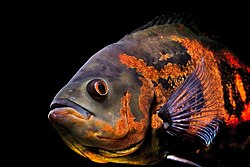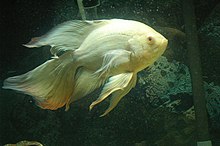User:Kaguya-Taketori/Sandbox/2
| 圖麗魚 | ||||||||||||||||
|---|---|---|---|---|---|---|---|---|---|---|---|---|---|---|---|---|
 | ||||||||||||||||
| 保护状况 | ||||||||||||||||
|
未予评估(IUCN 3.1)
| ||||||||||||||||
| 科學分類 | ||||||||||||||||
| ||||||||||||||||
| 二名法 | ||||||||||||||||
| Astronotus ocellatus (路易斯·阿加西斯, 1831) |
圖麗魚是慈鯛科中的一種。它的俗名包括奧斯卡、虎奧斯卡、天鵝絨慈鯛以及大理石慈鯛。[1]在其原棲息地南美洲,地圖魚是一種常常在當地市場上出售的食用魚類。[2][3]同時,圖麗魚在中國,美國,和澳大利亞亦有分佈。在美國,圖麗魚是一種很受歡迎的水族魚。[4][5][6]
分類[编辑]
這種物種最初由路易·阿加西命名為Lobotes ocellatus,因為他誤以為這種魚是海生的;之後經過研究,又將其劃到了圖麗魚屬(Astronotus)下。[7]該物種還擁有一些異名,包括:Acara compressus,Acara hyposticta,Astronotus ocellatus zebra,以及Astronotus orbiculatus。[8]
描述[编辑]

據報導,圖麗魚可以長到大約45 cm(18英寸)長,1.6公斤(3.5英磅)重。[1]野外捕獲的個體一般會是深色的,并在背鰭及尾梗上有眼斑或者黃色環紋斑點。[5]這些生長在野生的圖麗魚身上的眼斑被認為是旨在阻止食人鲳(英語:Piranha,Serrasalmus 屬)咬它的鰭。.[7][9]同時,圖麗魚還可以快速改變其體色。該行為是它們進行領域行為和攻擊行為的象徵。[10]幼年個體通常與成年個體的體色不同,它們身體上有白色和橙色的波浪形帶,頭上也有斑點。[7]
分佈及棲息地[编辑]

圖麗魚原產於秘魯,厄瓜多爾,哥倫比亞,巴西和法屬圭亞那 A. ocellatus is native to Peru, Ecuador, Colombia, Brazil, and French Guiana, and occurs in the Amazon River basin, along the Amazonas, Içá, Negro, Solimões, and Ucayali River systems, and also in the Approuague and Oyapock River drainages.[1][2] In its natural environment, the species typically occurs in slow-moving white-water habitats, and has been observed sheltering under submerged branches.[5] Feral populations also occur in China,[11] northern Australia,[12] and Florida, USA[13] as a byproduct of the ornamental fish trade. The species is limited in its distribution by its intolerance of cooler water temperatures, the lower lethal limit for the species is 12.9°C (55.2°F).[14]
Sexual dimorphism[编辑]
Although the species is widely regarded as sexually monomorphic,[5] males have been suggested to grow more quickly, and in some naturally occurring strains, males are noted to possess dark blotches on the base of their dorsal fins.[6][7] The species reaches sexual maturity around one year of age, and continues to reproduce for 9-10 years. Frequency and timing of spawning may be related to the occurrence of rain.[15] A. ocellatus fish are biparental substrate spawners, though detailed information regarding their reproduction in the wild is scarce.

The closely related Astronotus crassipinnis has been observed, in times of danger, to store food in its mouth, possibly for protection, in a manner reminiscent of mouthbrooding geophagine cichlids. This behaviour, however, has not yet been observed in A. ocellatus.[6] In captivity, pairs are known to select and clean generally flattened horizontal or vertical surfaces on which to lay their 1,000 to 3,000 eggs. Like most cichlids, A. ocellatus practices brood care, although the duration of brood care in the wild remains unknown.[6]
食物[编辑]
Captive oscars may be fed prepared fish food designed for large carnivorous fish, crayfish, worms, and insects (such as flies, crickets and grasshoppers). Feeding live foods may increase the rate of growth but also may cause endoparasites. Poultry and/or mammalian flesh, including beefheart, should not be fed long term as these fatty foods will contribute to fatty liver disease.[16] Since these fish eat fruit in the wild, items such as melons, oranges, and other fruits can also be used as a type of food. Just about anything that falls into the water would be eaten by oscars. Live feeder fish can be given, but fish such as goldfish and rosy red feeder minnows should not be fed. These contain an enzyme (thiaminase) within their flesh which binds vitamin B1, leading to deficiency. Most fish eaten by A. ocellatus in the wild are relatively sedentary catfish, including Bunocephalus, Rineloricaria, and Ochmacanthus species.[9] The species uses a suction mechanism to capture prey,[17] and has been reported to exhibit "laying-on-side" death mimicry in a similar fashion to Parachromis friedrichsthalii and Nimbochromis livingstonii.[18][19] The species also has an absolute requirement for vitamin C, and develops health problems in its absence.[20]
領域行為[编辑]
圖麗魚常常會在水族箱中宣稱一塊領域屬於自己,並且,當其它魚侵犯到自己的在水族館或湖中的領域時,就會變得極具攻擊性。而領域的大小通常取決於水族箱的大小和附近魚類攻擊性的強弱。一旦圖麗魚建立起了自己的領域,其它魚只要靠近,它們就會儘全力把它們趕出去。[21]
食物選擇[编辑]

A number of ornamental varieties of A. ocellatus have been developed for the aquarium industry. These include forms with greater intensity and quantities of red marbling across the body, albino, leucistic, and xanthistic forms. A. ocellatus with marbled patches of red pigmentation are sold as red tiger oscars, while those strains with mainly red colouration of the flanks are frequently sold under the trade name of red oscars.[22] The patterning of red pigment differs between individuals; in the United Kingdom, one A. ocellatus reportedly had markings that resembled the Arabic word for "Allah".[23] In recent years long-finned varieties have also been developed. The species is also occasionally artificially coloured by a process known as painting.[24]
腳註/來源[编辑]
- ^ 1.0 1.1 1.2 Froese, R. and D. Pauly. Editors. Astronotus ocellatus, Oscar. FishBase. [2007-03-16].
- ^ 2.0 2.1 Kullander SO. Cichlids: Astronotus ocellatus. Swedish Museum of Natural History. [2007-03-16].
- ^ Kohler, CC; et al. Aquaculture Crsp 22nd Annual Technical Report (PDF). Oregon State University, USA. [2007-03-16].
- ^ Keith, P. O-Y. Le Bail & P. Planquette, (2000) Atlas des poissons d'eau douce de Guyane (tome 2, fascicule I). Publications scientifiques du Muséum national d'Histoire naturelle, Paris, France. p. 286
- ^ 5.0 5.1 5.2 5.3 Staeck, Wolfgang; Linke, Horst. American Cichlids II: Large Cichlids: A Handbook for Their Identification, Care, and Breeding. Germany: Tetra Press. 1995. ISBN 1-56465-169-X.
- ^ 6.0 6.1 6.2 6.3 Loiselle, Paul V. The Cichlid Aquarium. Germany: Tetra Press. 1995. ISBN 1-56465-146-0.
- ^ 7.0 7.1 7.2 7.3 Robert H. Robins. Oscar. Florida Museum of Natural History. [2007-03-18].
- ^ Froese, R. and D. Pauly. Editors. Synonyms of Astronotus ocellatus. FishBase. [2007-03-21]. [失效連結]
- ^ 9.0 9.1 Winemiller KO. Caudal eye spots as deterrents against fin predation in the neotropical cichlid Astronotus ocellatus (PDF). Copeia. 1990, 3: 665–673.
- ^ Beeching, SC. Colour pattern and inhibition of aggression in the cichlid fish Astronotus ocellatus. Journal of Fish Biology. 1995, 47: 50. doi:10.1111/j.1095-8649.1995.tb01872.x.
- ^ Ma, X.; Bangxi, X.; Yindong, W. and Mingxue, W. Intentionally Introduced and Transferred Fishes in China’s Inland Waters. Asian Fisheries Science. 2003, 16: 279–290.
- ^ Department of primary industry and fisheries. Noxious fish – species information. Queensland Government, Australia. [2007-03-16]. (原始内容存档于2007-08-29).
- ^ United States Geological Survey. NAS – Species FactSheet Astronotus ocellatus (Agassiz 1831). United States Government. [2007-03-17].
- ^ Shafland, P. L. and J. M. Pestrak. Lower lethal temperatures for fourteen non-native fishes in Florida. Environmental Biology of Fishes. 1982, 7 (2): 139–156. doi:10.1007/BF00001785.
- ^ Pinto Paiva, M and Nepomuceno, FH. On the reproduction in captivity of the oscar, Astronotus ocellatus (Cuvier), according to the mating methods (Pisces – Cichlidae). Amazoniana. 1989, 10: 361–377.
- ^ Kmuda. Oscar Fish Diet. [23 May 2012].
- ^ Waltzek,TB and Wainwright, PC. Functional morphology of extreme jaw protrusion in Neotropical cichlids. Journal of Morphology. 2003, 257 (1): 96–106. PMID 12740901. doi:10.1002/jmor.10111.
- ^ Tobler, M. Feigning death in the Central American cichlid Parachromis friedrichsthalii. Journal of Fish Biology. 2005, 66 (3): 877–881. doi:10.1111/j.0022-1112.2005.00648.x.
- ^ Gibran,FZ. Armbruster, J. W. , 编. Dying or illness feigning: An unreported feeding tactic of the Comb grouper Mycteroperca acutirostris (Serranidae) from the Southwest Atlantic. Copeia. 2004, 2004 (2): 403–405. JSTOR 1448579. doi:10.1643/CI-03-200R1.
- ^ Fracalossi, DM; Allen, ME; Nicholsdagger, DK and Oftedal, OT. Oscars, Astronotus ocellatus, Have a Dietary Requirement for Vitamin C. The Journal of Nutrition. 1998, 128 (10): 1745–1751. PMID 9772145.
- ^ Oscar Fish Lover. OFL. [19 May 2013].
- ^ Sandford, Gina; Crow, Richard. The Manual of Tank Busters. USA: Tetra Press. 1991. ISBN 3-89356-041-6.
- ^ BBC News. Tropical fish 'has Allah marking'. BBC, UK. 2006-01-31 [2007-03-18].
- ^ Mike Giangrasso. Death by Dyeing – dyed fish list. Death by Dyeing.org. [2007-03-18].
